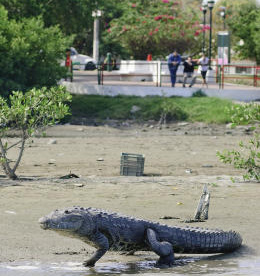
|  |  |  Editorials | Environmental | March 2009 Editorials | Environmental | March 2009  
Sinking Their Teeth Into Nature
 Dudley Althaus - Houston Chronicle Dudley Althaus - Houston Chronicle
go to original


| | People watch a crocodile in Tampico, Mexico. Once reviled, the beasts now are considered mascots. (Keith Dannemiller/The Chronicle) |  |
Legions of crocodiles swarm in a city lake and wetlands, but residents of Tampico treat the beasts with respect.

Tampico, Mexico — Monsters dwell here.

At least 65 crocodiles throng the 200-acre Laguna Carpintero — Carpenter’s Lake — a short walk from Tampico’s central square.

Unknown legions more thrive in the wetlands and estuaries on the city’s fringe, where new residential neighborhoods march right up to the water’s edge.

“They’ve gone from being just one more inhabitant of the lagoon to being icons of the city,” Mario Castellanos, a municipal biologist, said of the pampered pride of Tampico, an oil refining and port city 250 miles south of the Texas border.

“What we are trying to do,” he said, “is provide them with security.”

The city’s lake offers an extreme example of crocodiles’ increasingly urban lifestyles.

But the predators roam throughout Mexico.

Humans and reptiles

A 2001 census estimated Mexico’s crocodile population at nearly 80,000, distributed along the country’s coasts and sometimes far inland. Hundreds inhabit Cancun’s Nichupte Lagoon, which separates the city from its seafront hotels. Many more live along the Maya Riviera coast south of Cancun. Still others meander around Puerto Vallarta, Zihuatenejo, Acapulco and other destinations.

“There are crocodiles in all the beach areas and coastal marshes,” said Marco Lazcano, a Cancun-based biologist who studies the reptiles. “These species are recovering at the same time that human populations are growing in these areas.”

Though Mexican crocodiles have been found within a few hundred miles of the Rio Grande, none has been spotted in Texas, experts say.

Tampico’s crocs garnered international headlines last summer when an out-of-towner — who witnesses said appeared to be drunk or on drugs — hopped the railing of an observation platform and walked among the animals on a Laguna Carpintero sandbar.

Dangerous creatures

One of the crocodiles grabbed the interloper, who remains unidentified, and pulled him into the lagoon. The man’s body appeared the next morning, bitten and drowned — but not eaten.

A wading fisherman near Tampico bled to death last spring when a crocodile he had snared in a net tore off part of his leg. Local biologists suggest the fisherman may have been trying to poach the beast, whose meat and hide bring good prices.

Crocodiles occasionally attack waders and wandering tourists in Cancun, as well.

“Being close to a crocodile can be very dangerous,” said Luis Sigler, another Mexican crocodile expert now with the Dallas World Aquarium.

Nowhere in Mexico do people get as cheek-to-jaw with the reptiles as they do in the Laguna Carpintero.

Teeth and picnics

Long the reeking cesspool for central Tampico, the lake has been cleaned up over the past two decades. A new convention center and a theater complex anchor the eastern shore. People picnic in the parks that line the western rim.

Crocodiles live throughout the lake. The animals’ nesting grounds sit between the convention center and a busy street. But most of the bigger beasts lurk in the far northern reaches, near a thick stand of mangroves where tropical birds and iguanas the size of poodles perch.

Amid last summer’s flooding rains, dozens of the reptiles — some weighing in at 400 pounds or more — wandered on shore, hunkering a few yards from jogging trails and children’s swing sets.

Their fascination overcoming fear, locals and tourists alike approached the beasts, snapping photographs, daring one another to move just a little closer, bringing children to share in the experience.

Living in harmony

Such encounters make experts like Lazcano, who otherwise thrill at the reptile’s resurgence, cringe.

“The danger of a fatality exists,” Lazcano said. “If tomorrow a crocodile kills a child, everyone around the lagoon is going to start killing crocodiles.”

Indeed, people in Tampico weren’t always crazy about the beasts. Earlier in the decade local media led a public outcry to remove the reptiles.

City ecologists sought help from outside experts to defuse the protests. Steve Irwin, the late Australian crocodile hunter of television fame, responded to the call with a 2003 visit.

“This lake and this city will be a showcase for the world that will demonstrate clearly that people can live in harmony with sharp-teethed wild animals,” Irwin said at a news conference.

From that point on “crocodiles had a different image in the city,” said Alejandro Fierro, who headed Tampico’s environment office at the time. “There was not a single criticism in the press.”

What’s on the menu

But though Tampico’s crocs may now be the city’s mascots, they are hardly its pets. Because the beasts haven’t yet preyed upon their warm-blooded neighbors doesn’t necessarily mean they won’t.

“Crocodiles are opportunistic animals,” said Sigler, the specialist in Dallas.

“Once they learn to eat easy food — whether it be a domestic pet or a human being — they will.”

dudley.althaus(at)chron.com |

 |
|  |



